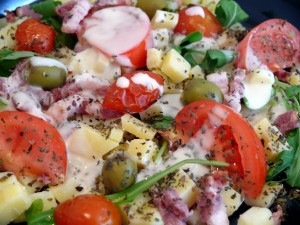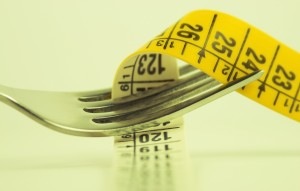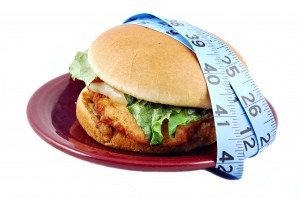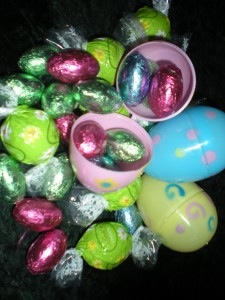A Healthy Meal Or A Caloric Fat Fest?
It’s time for lunch or perhaps to pick up a bite for dinner on your way home. It’s Monday after a weekend of a bit of overeating. Time for something light and healthy.
How about a salad? Here’s a chance for plenty of vegetables, other healthy stuff, and a chance to save some calories, too. Yeah, right!!! Think again and read on.
Wonderful Reasons To Have A Salad
There are a whole bunch of good reasons to chow down on a nice big salad.
- It’s easy to make your own from the salad bar at the local market, to order one for delivery, or to rip open a bag of lettuce and plop a piece of grilled chicken on top.
- The nutrient rich plant foods that make the base of a salad are high in antioxidants — especially the dark green and orange vegetables, and legumes.
- Most of the vegetables are full of fiber – good for your cholesterol, your GI functioning, and as a way to feel fuller for a longer period of time.
- Salads take a long time to eat – much longer than sandwiches or pizza that you can scarf down far more quickly.
- Salads can look really appetizing and can cost very little (they can cost a lot, too, depending upon the add-ons).
- Salads are a great way to recycle leftovers – just toss them in the mix.
Where’s The Nightmare?
Answer: Hidden in the fatty and sneaky high caloric add-ons and dressing.
- Generally, at least ¼ of a cup (frequently more) of dressing is added to a tossed salad. A ladle of creamy dressing has about 360 calories and 38g of fat (a cheeseburger’s worth). Vinaigrette dressing, usually 3 parts oil to one part vinegar, adds its own fat blast.
- Tuna, macaroni, and chicken salads, the holy grail of delis and salad bars, are loaded with mayonnaise, which of course, is loaded with fat. On average (for a half cup): chicken salad has 208 calories, 16g of fat; tuna salad has 192 calories, 9g fat; tuna pasta salad has 397 calories, 9g fat; macaroni salad has 170 calories, 9g fat.
- Cheese, please – or maybe not. For a 1/4 cup serving: Shredded cheddar has 114 calories, 9g fat; blue cheese has 80 calories, 6g fat; feta has 75 calories, 6g fat.
- Portions: The calorie counts above are for ½ cup of salad, ¼ cup of cheese. Those are pretty small portions. Do you have that kind of restraint?
- Croutons and Crispy Noodles: ¼ cup of plain croutons has 31 calories, 0g fat; 1 serving of McDonald’s Butter Garlic Croutons has 60 calories, 1g fat; ¼ cup of crispy noodles has 74 calories, 4g fat
- Dried cranberries: ¼ cup has 98 calories, 0g fat
- Nuts and Seeds (1/4 cup): Sunflower seeds have 210 calories, 19g fat; chopped walnuts: 193 calories, 18g fat
- Avocado (1/4 cup) have 58 calories, 5g fat
- Bacon: 1 tablespoon of bacon bits has 25 calories, 2g fat
- Bread (often used to sop up leftover dressing): 1 piece of French bread has 82 calories, 1g fat; 1 dinner roll has 78 calories, 2g fat
- Dressing sopped up by the bread or roll: lots of extra fat calories!
Should Salads Go On Your “Do Not Touch” List?
No way, absolutely not. The healthy stuff in salad tastes great, fills you up, and is good for you. There are plenty of ways to cut down on the fatty and caloric add-ons and still end up with a really tasty meal. There are even good choices in fast food and chain restaurants (and plenty of really, really bad ones).
SocialDieter Tip: don’t stop eating salad, just be aware of what add-ons and dressing can do. Check my next post for some very helpful info on choosing and making salads and for the low down on a few fast and chain food “good” and “don’t even think about it” choices.




